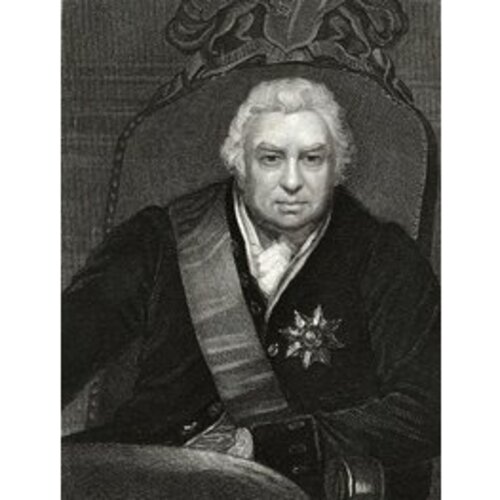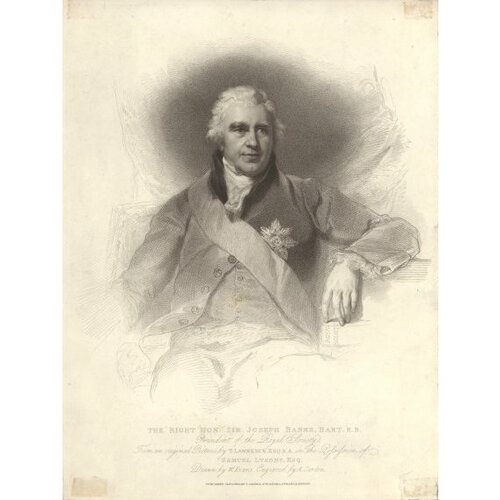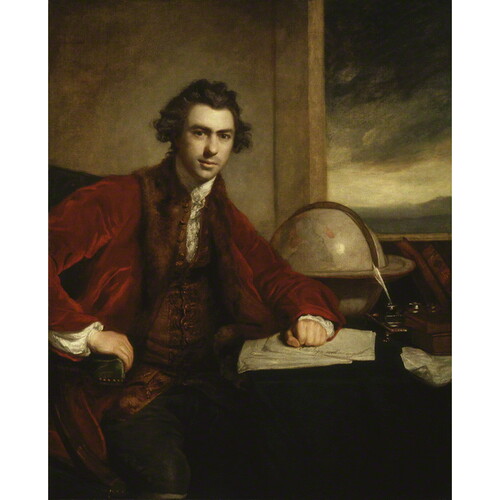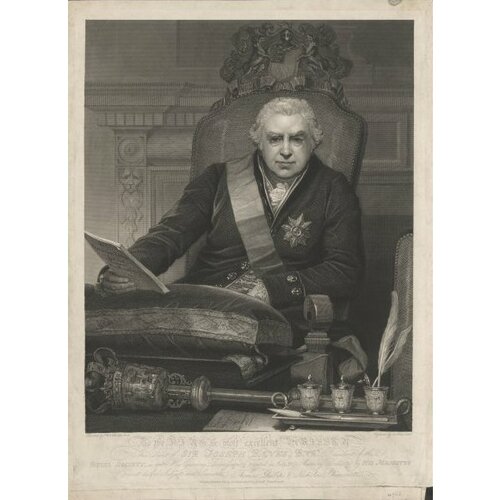As part of the funding agreement between the Dictionary of Canadian Biography and the Canadian Museum of History, we invite readers to take part in a short survey.
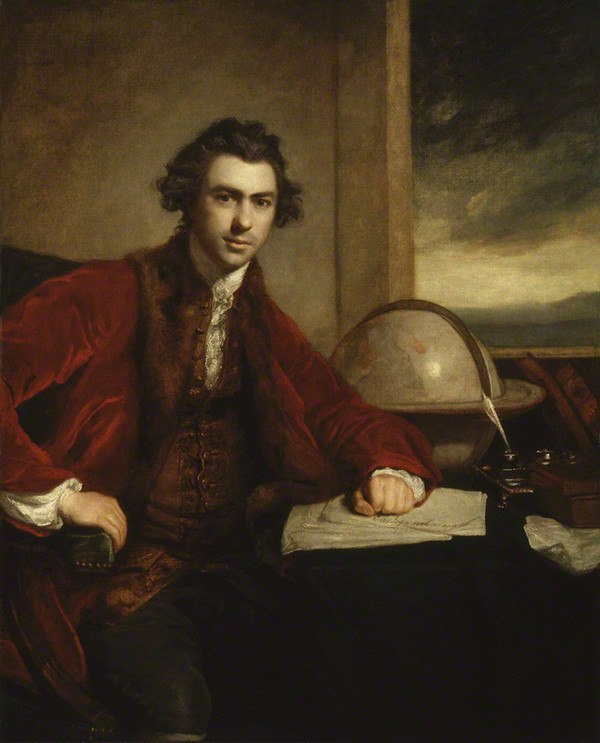
Source: Courtesy of Wikimedia Commons
BANKS, Sir JOSEPH, naturalist; b. 2 Feb. 1742/43 in London, England, only son of William Banks and Sarah Bate; m. there 23 March 1779 Dorothea Weston-Hugessen; d. 19 June 1820 in Heston (London).
Born into a family with considerable wealth and powerful connections, Joseph Banks also inherited acute intelligence from both sides. From the beginning, influences were at work to determine his future career. His relations’ estate at Burghley House in Northamptonshire had gardens splendidly laid out by the Elizabethan statesman William Cecil, who had a special flair for acclimatizing exotic trees and shrubs. Family connections linked Banks to Lord Temple, whose gardens at Stowe were among the most famous in England, and Banks’s family home at Revesby Abbey in Lincolnshire adjoined vast undrained fens with astonishing populations of waterfowl. It is not therefore surprising that when a schoolboy at Eton College Banks became attracted to natural history and applied himself to its study. About 1761 or so, while attending Oxford, he began to build up a herbarium, and among its early sheets is a plant of Geum macrophyllum from Labrador dated 1763. A little later, plants from this region were given to him by Moravian missionaries, whose London headquarters were close to his home; it was probably through their accounts that he became interested in Greenland and Labrador. In 1766 he obtained permission for himself and Constantine John Phipps, a naval officer and former school-friend, to travel as passengers to Newfoundland in the Niger, part of the squadron of Governor Hugh Palliser*. In addition to her normal patrol duties, the Niger was taking a party of marines to Chateau Bay in Labrador to erect a blockhouse for a permanent garrison [see Francis Lucas*]. She anchored in St John’s on 11 May 1766, a stimulating time for a naturalist. Among the birds in full breeding plumage, Banks recorded the resident black-capped chickadee; robins were plentiful and conspicuous, and there were numerous warblers. Banks was soon busy collecting many different types of plants and birds, and when intermittent snowstorms prevented this activity he went trawling in the harbour for marine life or made geological observations on rock faces then being exposed by men levelling an area for fortifications. His interest attracted attention and the locals brought him specimens. On 6 June he commented in his journal on plant distribution, which was to be a lifelong interest: “Wlkd out to day gatherd some of the Northern English Plants which grow here Every where not Coveting high Land,” among them “the Little dwarf Honeysuckle, Cornus herbacea,” and “a beautiful Kind of . . . Medlar [an Amelanchier, now widely treasured in English gardens].”
On 11 June the Niger sailed for Croque, an isolated fishing settlement on the east coast of the Northern Peninsula, where Banks made further observations and collecting trips. Illness prevented his working through much of July, but he was able to collect again when the arrived on the Labrador coast on 9 August. He had ceased keeping a day-to-day journal in June, and his comparison the British and French fisheries at Croque was written after his arrival in Labrador. Banks commented that “they Differ much in their methods of Fishing and have Each their Different merits,” although he considered that “the Englishman indeed has the advantage as he catches considerably a larger quantity of Fish & his Fish fetch more money at Foreign markets being better cured.” He then went on to describe the gutting and drying of fish, the various types of bait, and the kind of boats used, adding that British methods were in essentials much in advance of the French “but in the neatness of their Stages & manner of working they are much our superiors.”
One of the most interesting aspects of Banks’s records from an ornithological point of view is his arrival in Newfoundland when the spring migrants were abundant and his reaching Labrador three months later when the fall migrants were coming south in their thousands. In a letter to a former school-friend on 10 August he wrote, “This Morn went out shooting upon Labrador . . . a bird of Passage Call’d here Curlew who came 4 or 5 days ago in amazine multitudes they are very like the Curlew Jack [whimbrel] in Enland & every body here agrees most excellent eating I am Just going to set down to Dinner on some of them Broil’d. . . .” Banks took specimens back to England, and an engraving of one of these now almost extinct Eskimo curlews appeared in Thomas Pennant’s Arctic zoology (2v., London, 1784–85). Banks’s interest in archaeology was aroused by the discovery the previous year of a large quantity of whalebone on Esquimaux Island, north of the entrance to Chateau Bay, “Carefully & regularly buried upon tiles” and “supposed to be Left here by the Danes who in their Return from Groenland South about touchd upon this Coast & Left several Whaling Crews.” This observation was paralleled by one made by the Moravian missionaries Christian Larsen Drachart* and Jens Haven* on nearby Henley Island, and both have a special significance in view of the archaeological work now being carried out on the ancient Basque fisheries at Red Bay just down the coast.
When the Niger had fulfilled her commitments she sailed for St John’s, arriving on 10 Oct. 1766. Banks commented, “We all Felt great Pleasure in Returning to Society which we had so long been deprivd of St Johns tho the Most Disagreeable Town I Ever met with was For some time Perfectly agreable to us . . . it is Built upon the side of a hill facing the Harbour Containing two or three hundred houses & as near as many fish flakes interspersed which in summer time must Cause a stench scarce to be supported.” “As Every thing here smells of fish so,” he recorded, “You cannot get any thing that does not taste of it. . . .” On 25 October Governor Palliser gave a formal party in honour of the anniversary of the coronation of George III; ladies were so few on the island, Banks noted, that even his washerwoman was amongst the guests. An extraordinary group of gifted men was gathered in St John’s at the time, among them John Cartwright, Palliser’s first lieutenant and later a friend of Banks, and his brother George, who became one of Banks’s collectors of plants and animals on the Labrador coast. The crew of Palliser’s flagship the Guernsey included several men who were to play important roles in James Cook*’s Pacific explorations; James King*, for example, an able seaman with a flair for mathematics and astronomy, was to bring the Discovery home from the third voyage. Cook himself arrived in St John’s harbour on 27 October.
Once the Niger had returned to England Banks set to work classifying and recording his collections with the help of the Swedish naturalist Daniel Carl Solander, who became one of his closest friends. After travels in Britain during the autumn of 1767 to examine various technological installations he returned to London in January 1768 and there heard of Cook’s projected voyage to make observations at Tahiti on the transit of Venus. Banks, realizing that the Endeavour would visit countries unknown to any European naturalist, obtained permission to join the expedition. With him went Solander and a small, well-trained staff of scientists, draughtsmen, and collectors usually but incorrectly referred to as Banks’s servants. The observations and collections made on this voyage were to provide biologists and ethnologists with a rich variety of material which is still being worked on. Furthermore, the value of sending scientists on all voyages of exploration was securely established, and the foundations of marine biology were laid. Banks’s interest in languages and his personal flair for dealing with the inhabitants of lands scarcely if at all visited by Europeans were of fundamental importance in establishing peaceful relationships so that Cook could devote himself to navigation and surveying. The strong friendship that grew up between the two men is apparent from many details in their respective journals.
On their return to England in 1771 Banks and Solander, his chief companion of the voyage, were lionized. A second Pacific voyage was planned, and Banks assumed he would be in charge, but he withdrew in anger after accommodation for his party had to be considerably reduced. Instead he took his staff to the Inner Hebrides, Iceland, and the Orkney Islands to make archaeological and geological observations. At Christmas time of 1772 George Cartwright arrived in England with a family of Inuit; Banks paid them many visits, had them painted, and questioned them carefully about their customs and beliefs. When Phipps, his companion on the Niger, was commissioned the same year to search for a passage northeast to India by way of the Arctic, Banks gave him a long list of desiderata: he needed information on bird and fish migrations, sea water, and ocean currents, and he asked for biological specimens. His persistent interest in the Arctic is shown in much of his correspondence, particularly in the letters received from William Scoresby, a pioneer explorer of Arctic seas.
While Phipps was away on his voyage in 1773 Banks took an active part in the running of the Royal Botanic Gardens at Kew (London), work that was to result in the development of the gardens as a great storehouse of living plants from all over the world. Early intensive work on the florae of southern Africa, Australia, and the Pacific coast of Canada was largely due to his efforts, and in addition to being in effect the director of the gardens until his death, Banks also became George III’s unofficial scientific adviser. In 1776 he moved to a new house in London which had adequate room for his growing library and herbarium, and after his marriage he purchased still another house, Spring Grove at Heston, which had an extensive garden. A fellow of the Royal Society from 1766, he became president in 1778. He held this position until his death, and displayed an active interest in the administration of the society. In 1781 he was created a baronet.
Banks was one of the most influential persons connected with science in the 18th century, and his range of professional interests extended over the whole kingdom of living creatures. At the same time a geographer in the fullest meaning of the word, he assisted William Roy in the founding of the Ordnance survey and William Smith in the production of the first geological map of the United Kingdom. Deeply interested in the development of Australia, he has been called the father of the country. He was closely connected with the voyages in Australian waters of Matthew Flinders, who was accompanied by Banks’s own librarian, Robert Brown. Moreover, he was successful in obtaining Spanish merino sheep for breeding in England and then in Australia, although these efforts are less well known than his sponsorship of Captain William Bligh in the famous attempts to transfer bread-fruit from Tahiti to the West Indies. For many years Banks was associated with Matthew Boulton in his attempts to reform the currency, and he was also one of the founders of the African Association, and a supporter of Mungo Park in his travels to find the source of the Niger River. Thanks in part to Banks’s efforts the Royal Institution, an organization for the promotion of science, was founded in 1800, and it rapidly became one of the most important independent research institutions in Europe.
Although crippled with gout for the last 30 years of his life, Banks retained his wide-ranging curiosity until his death. One characteristic suggests how this curiosity led to his many activities: he had the gift of finding interests in common with people of all ages and classes, which made his life one of perpetual, rich discovery in the widest sense. Equally at home with kings, gardeners, and scientists, he was a pallbearer for Samuel Johnson as well as for William Aiton, the great Kew gardener. Typically, he asked that his own funeral be as simple as possible. Banks is commemorated in Canadian waters by Banks Island off the British Columbia coast, named in 1788 by Archibald Menzies*, who had been a collector for Banks, and by Banks Island in the Arctic Archipelago, named shortly after Banks’s death by William Edward Parry*. Parry had paid a visit to Banks in 1817 and his account tells how they discussed Greenland ice: surely an event typical of Banks’s whole life as a man of science.
[Banks’s meticulously ordered papers met a dismal fate after his death when many of the documents were put up for sale by a relative in defiance of Banks’s provision that the manuscripts were ultimately to be deposited in the British Museum. As a result of various auctions the material was scattered all over the world; what is available in Canada includes his manuscript of Newfoundland plants and birds and some paintings of Newfoundland birds, all at the McGill Univ. Libraries (Montreal). Because authoritative material was not readily accessible Banks fell into relative obscurity after his death, and no definitive biography has been published. Such a work was written by Edward Smith early this century, but after repeated rejections by publishers he shortened it into a popular work entitled The life of Sir Joseph Banks . . . (London and New York, 1911; repr. New York, 1975). It was the only biography available until the appearance of Hector Charles Cameron’s short but carefully documented study, Sir Joseph Banks, K.B., P.R.S., the autocrat of the philosophers (London, 1952). Charles Lyte has since published a popular life entitled Sir Joseph Banks (Newton Abbot, Eng., 1980). a. m. l.]
Joseph Banks, The Endeavour journal of Joseph Banks, 1768–1771, ed. J. C. Beaglehole (2v., Sydney, Australia, 1962); The journal of Joseph Banks in the Endeavour (Guildford, Eng., 1980); “Some early letters from Joseph Banks (1743–1820) to William Phelp Perrin (1742–1820),” ed. A. M. Lysaght, Royal Soc. of London, Notes and Records (London), 29 (1974–75): 91–99. The Banks letters: a calendar of the manuscript correspondence of Sir Joseph Banks . . . , ed. W. R. Dawson (London, 1958). The journals of Captain James Cook on his voyages of discovery, ed. J. C. Beaglehole (4v. in 5 and portfolio, Cambridge and London, Eng., 1955–74), 1. A. M. Lysaght, “A note on the Admiralty copy of Cook’s journal in the Endeavour,” “Joseph Banks in the Niger and the Endeavour,” and “Banks’s artists in the Endeavour,” in James Cook, The journal of H.M.S. Endeavour, 1768–1771 (Guildford, 1977), 10–12, 25–36, and 37–47 respectively. ADB. DNB. DSB. A. M. Lysaght, Joseph Banks in Newfoundland and Labrador, 1766: his diary, manuscripts and collections (London and Berkeley, Calif., 1971). Yolande O’Donoghue, William Roy, 1726–1790: pioneer of the Ordnance Survey (London, 1977). A. M. Lysaght, “Joseph Banks at Skara Brae and Stennis, Orkney, 1772,” Royal Soc. of London, Notes and Records, 28 (1973–74): 221–34; “Some eighteenth century bird paintings in the library of Sir Joseph Banks (1743–1820),” British Museum, Natural Hist., Bull., Hist. Ser. (London), 1 (1953–59): 254–371.
Cite This Article
Averil M. Lysaght, “BANKS, Sir JOSEPH,” in Dictionary of Canadian Biography, vol. 5, University of Toronto/Université Laval, 2003–, accessed March 29, 2025, https://www.biographi.ca/en/bio/banks_joseph_5E.html.
The citation above shows the format for footnotes and endnotes according to the Chicago manual of style (16th edition). Information to be used in other citation formats:
| Permalink: | https://www.biographi.ca/en/bio/banks_joseph_5E.html |
| Author of Article: | Averil M. Lysaght |
| Title of Article: | BANKS, Sir JOSEPH |
| Publication Name: | Dictionary of Canadian Biography, vol. 5 |
| Publisher: | University of Toronto/Université Laval |
| Year of revision: | 1983 |
| Access Date: | March 29, 2025 |


